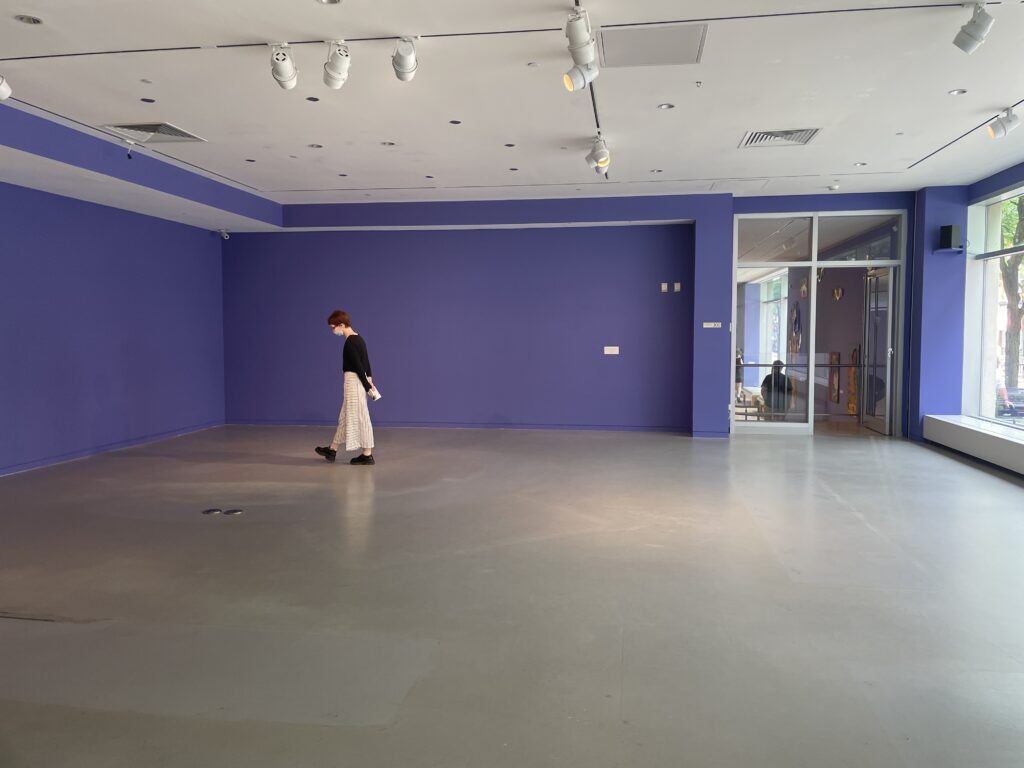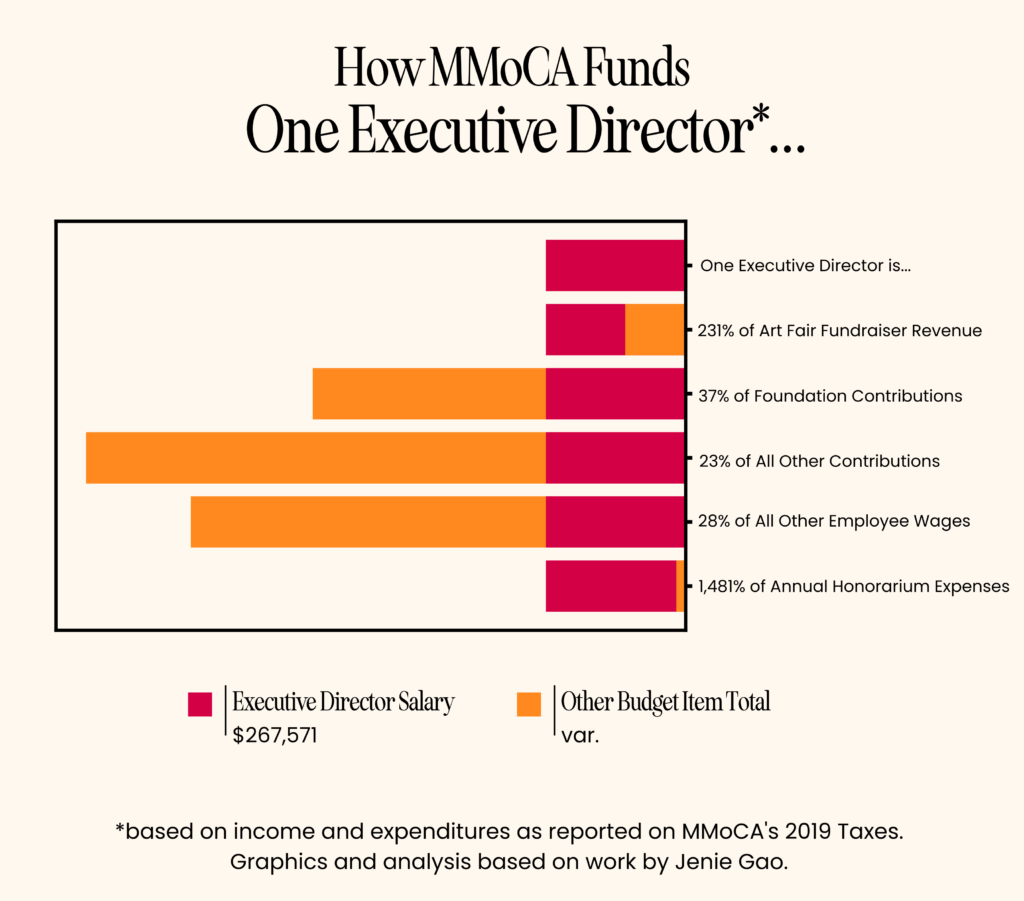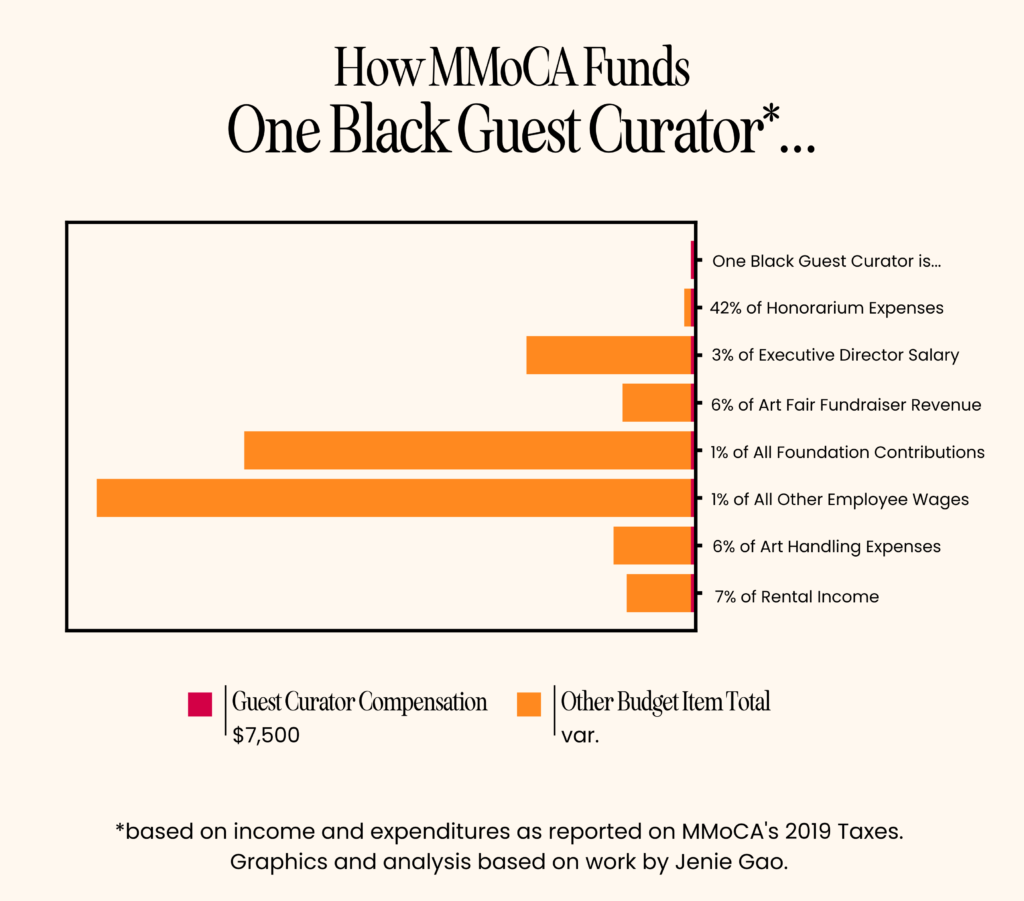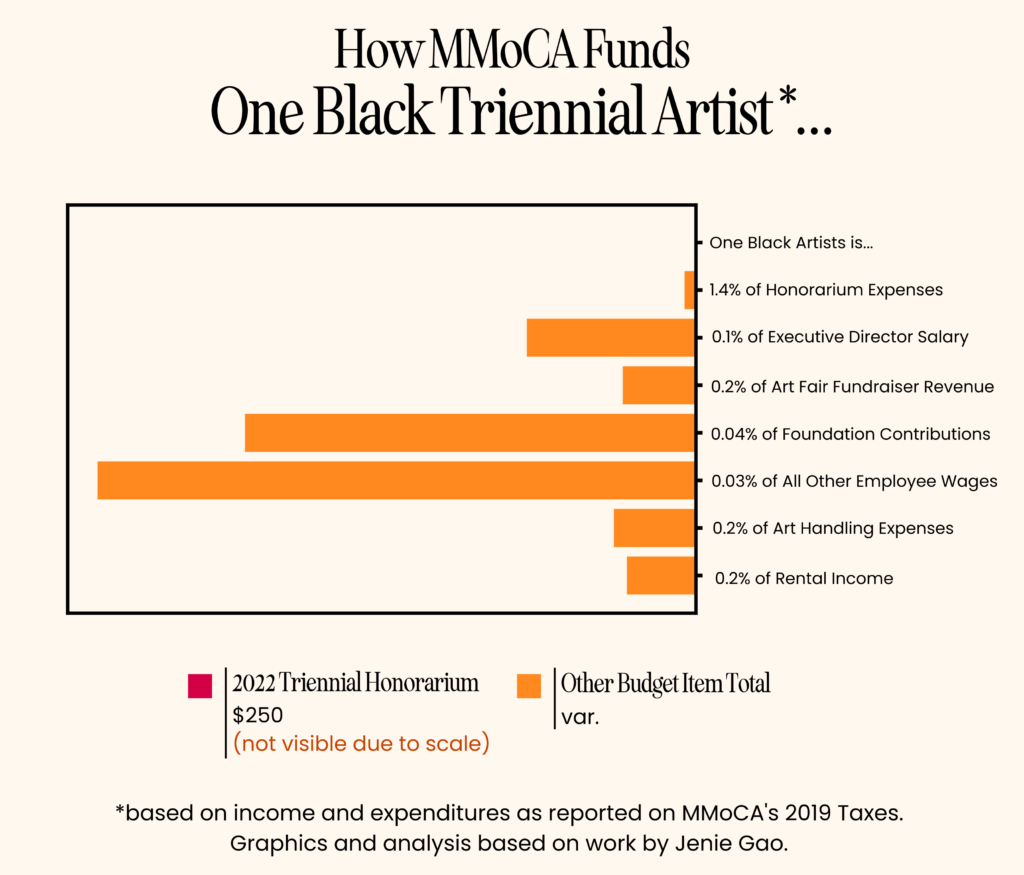From curator and artist compensation to promotion and programming, MMoCA and its leadership failed to provide the promised and conventional support standard for a show of this scope and stated significance.
In the 2021 call for Guest Curator applications and Proposals, MMoCA described the Triennial Exhibition as an essential “cornerstone of the Museum’s exhibition programming.”
It is challenging to reconcile the importance the institution ascribes to the show, even before its participants and themes were announced, with the complete lack of support and follow-through demonstrated in the period since.
Inadequate Compensation
Stipend Inequity
According to their most recent tax filings, available via ProPublica, the 2020 executive compensation of the former MMoCA Director was $267,571.
In the Madison Museum of Contemporary Art’s open call for guest curators, the listing states that selected applicant(s) will receive a stipend of $7,500 along with staff guidance, support, and mentorship.
At a rate of $17.52/hr, according to MIT’s Living Wage for the city of Madison, this curatorial stipend would equate to only 10 weeks of compensation at minimum livable income for over one year of related labor supporting a nearly six-month exhibition.
Honorarium Resourcing
"The murals were going up, in process. It was wonderful to walk around the corner and suddenly see artists pulling out their paints and brushes. You know they’d been planning for hours to get to that point. It’s exciting, it’s invigorating, to see an artist in their moment of creation, responding to a moment in time."
For the first time in the 43-year history of the Wisconsin Triennial, artists were paid honorariums. These honorariums were $250 each.
While there is not a commonly-held standard for artist compensation, W.A.G.E. is an artist-run organization that has worked for over a decade to establish a sustainable economic relationship between artists and the institutions that contract our labor. For a group exhibition of 6-plus artists, W.A.G.E. recommends that institutions pay .03% of their total annual operating expenses.
In 2020, MMoCA’s total annual operating expenses were $3,044,792. Following W.A.G.E.’s guidelines, artists in a group exhibition in 2022 could fairly expect to each be paid between $917 and $1068.
Budgetary Concerns
Budgets are moral documents. What does MMoCA’s budget say about their values and our value?
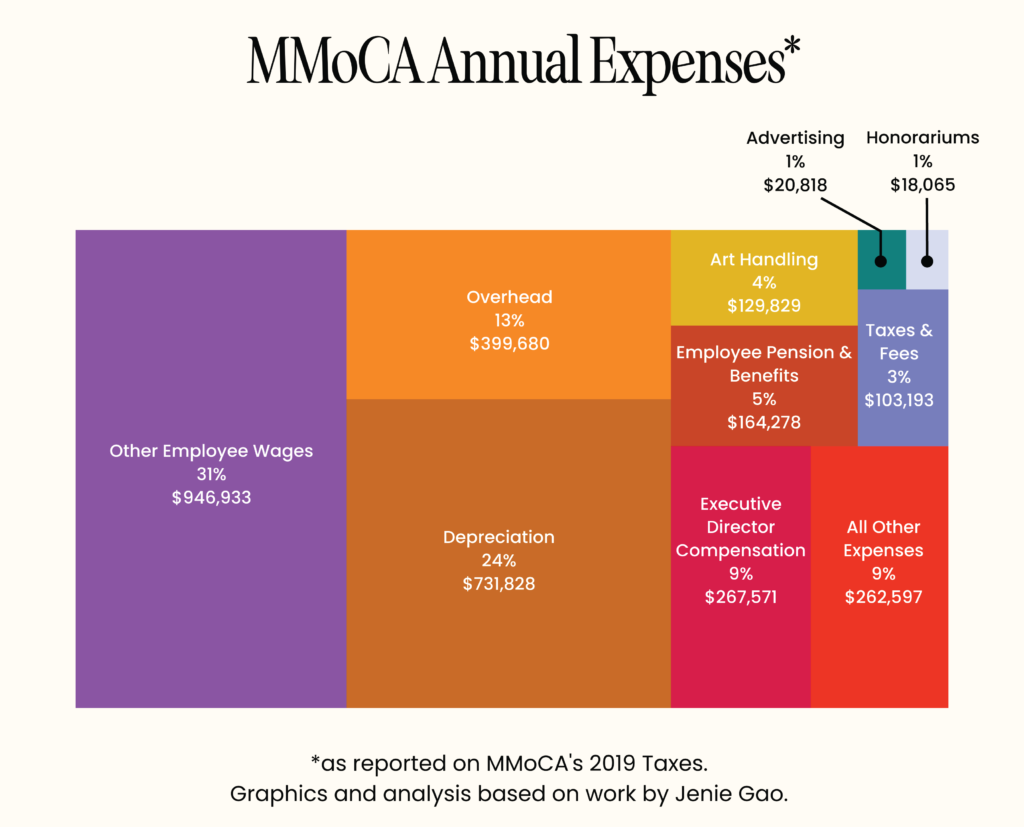
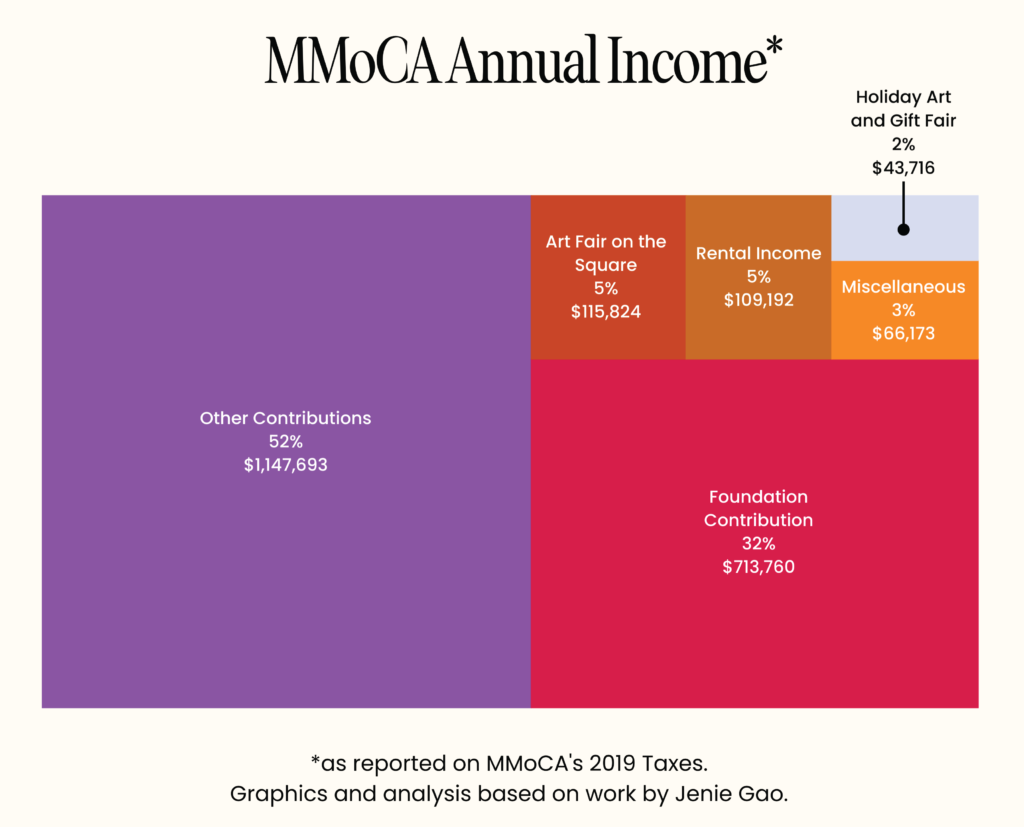
The museum’s budget and expenses represent MMoCA’s institutional priorities. Compare three funding allocations: Executive Director salary ($267,571*), the guest curator stipend ($7,500), and Triennial Artist Honoraria ($250/ea).
The Executive Director’s salary outstrips the entire annual allotment for artists’ honorariums by a factor of almost 15.
Arts and culture organizations have been severely impacted by financial and populational concerns surrounding the COVID-19 pandemic. According to a May 2022 report from the NAAPPD, the arts are recovering significantly slower than other industries as COVID-19 continues to disrupt in-person programming.
Artists and creatives continue to be among the most severely affected populations within the workforce. At the height of the pandemic in 2020, 63% of artists and creatives experienced unemployment and 95% lost creative income. 37% of artists were unable to access or afford food at some point during the pandemic and 58% did not visit a medical professional due to an inability to pay.
BIPOC artists had higher rates of unemployment than white artists in 2020 (69% vs. 60%) and lost a larger percentage of their creative income (61% vs. 56%) due to the pandemic.
As an open-admission and free-to-the-public museum that shuttered its gift shop and restaurant, MMoCA would have been insulated from concerns around ticket sales income and diminished spending by guests. While donations may have decreased, a changing bottom line need not have informed percentages of the total budget allocated for such fundamental operations as securing art, compensating curators, and recognizing artists.
* Based on the latest tax filings available on ProPublica.
Promotional Negligence
The Madison Museum of Contemporary Art promised to provide support for the exhibition, including regular promotion.
A thorough review of MMoCA’s social media activity reveals that all promotions halted in early June. This negligence had a significant impact on the intent of the exhibition, the development of the involved artists, and public awareness.

Since the exhibition opening on April 23, MMoCA’s 2022 Wisconsin Triennial has only been promoted 9 times via their social channels.
No promotional posts have appeared since June 9 on Instagram, Twitter, or Facebook.
Promotions only spanned 28% of the scheduled duration of the show.
As of September 1, 2022, promotions have only appeared on 4% of the days of the planned exhibition duration.
For more details on Instagram and Twitter activity, see below.
Instagram Activity
Reviewing from mid-August 2022 through mid-December 2021, this slideshow tracks MMoCA’s official Instagram account activity (@mmocamadison). Please note: these screenshots are in reverse chronological order as they appear on Instagram.
All posts related to the Triennial are indicated with a purple filter; unrelated posts are marked with a white filter. Related events from the timeline have been cross-referenced and captioned. Click to see date ranges.
There has been no posted Instagram promotion of the Triennial since June 9. As of publication on Aug. 19, the most recent story in the pinned highlight promoting the exhibition was from 14 weeks earlier. This is estimated to be posted in mid-May.
UPDATE: A screengrab from Aug. 27 reveals that MMoCA updated their pinned story highlights for the “Ain’t I A Woman?” exhibition. The pinned highlight now features more recent stories about the exhibition, including reposts of content generated by museum visitors.
As of this update, the “most recent” pinned story is from 9 weeks earlier (est. early July.) These are recent additions, established by the fact that the “Ain’t I A Woman?” highlight moved to the top position in MMoCA’s pinned highlights.
This update is the only external evidence so far that the museum has received, reviewed, and responded to any of our concerns. MMoCA’s August 24 press and donor statement only opaquely refers to “a series of articles, e-mails, and letters.”
Twitter Activity
A survey of all tweets published by the MMoCA official Twitter account (@mmocamadison) between March 1, 2022, and August 19, 2022, further suggests the lack of institutional support and enthusiasm offered to the 2022 Wisconsin Triennial Exhibition.
Of the 234 tweets published in this time period: Mel Chin’s There’s Something Happening Here, open from March 5 through July 31, received 27 promotional tweets.
The 2022 Wisconsin Triennial exhibition, open from April 23 and slated to remain open through October 9, was the subject of only 8 promotional tweets over the same period of time.
MMoCA uses its Twitter feed to build support and an audience for the shows it has invested in. Mel Chin’s show received 338% more promotional activity than Triennial on Twitter in this time period, despite having been open to the public for only 30 days longer than the 2022 Wisconsin Triennial.
There has been no Twitter promotion of the 2022 Wisconsin Triennial since June 9.
The most recent promotional Tweet for Mel Chin’s show was published on June 28 — four days after the mismanaged response to the defacement and theft of Lilada Gee’s work, one day before the rest of the artists were informed (after local press coverage began), and almost twenty days after the last promotion of the Wisconsin Triennial.
As of publication on August 19, this tallies up to 72 days without promotion on any of MMoCA’s social channels (including Facebook.)
Programming Disparity
Exhibition Opening
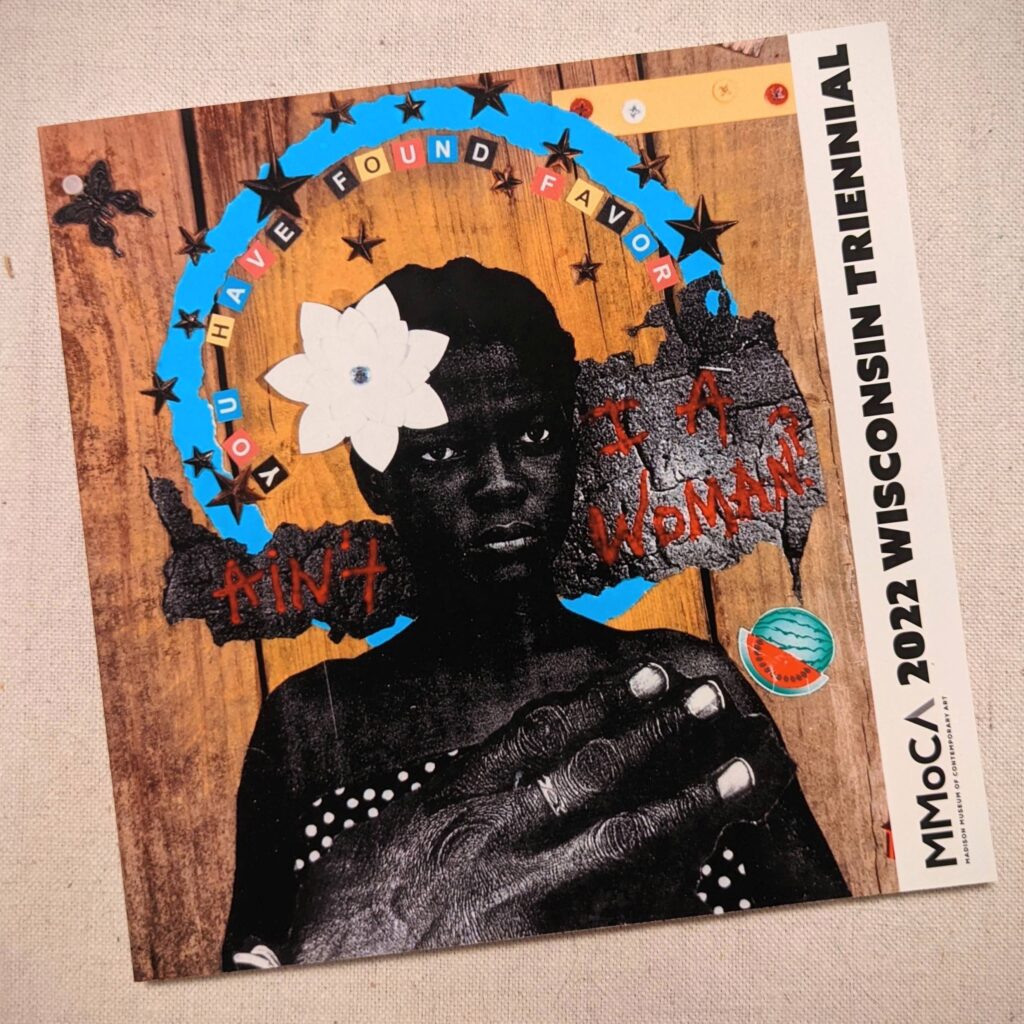
Even at the exhibition opening on April 23, several details indicated an absence of thorough institutional support and planning for the popularity and scale of the event. The exhibition opening was attended by an estimated 600 guests.
Upon entry, many guests were given misleading communication about the scale of the exhibition and were unable to obtain exhibition catalogs due to low supply. To echo the September 2021 “Letter in Support of Fatima Laster”: widely accessible, cross-disciplinary documentation is an essential method to ensure that this historic exhibition remains available to future artists, curators, scholars, and community members.
There were repeated issues with institutional A/V support, resulting in significant delays and discomfort for both presenters and the audience. Performances were delayed for 45 minutes. The climate control system was unable to maintain safe and comfortable temperatures for occupants of the standing-room-only auditorium during the U.S. surge of the COVID-19 Omicron variant. Critically, the mortality rate of COVID-19 disproportionally affects Black women.
Although the exhibition covered the entire first floor, including multiple galleries and unmarked common spaces, museum greeters exclusively indicated that the Wisconsin Triennial exhibition was on display in the State Street Gallery. (Even when asked for clarification regarding work outside of those galleries, greeters repeated this direction.)
The present staff was noticeably overwhelmed and under-resourced. Even at the exhibition opening, MMoCA’s leadership’s oversights and failures demonstrated an institutional carelessness now inseparable from major and repeated instances of institutional harm.
As stated in the Open Letter, we anticipate that the museum may elect to put the brunt of responsibility on staffers and we reject it. We anticipate this because the museum and its leadership have demonstrated an acute and consistent pattern of offloading blame onto, up to the point of misrepresenting communications with, the show’s curator and minoritized support staff.
It is the institution’s responsibility to support artists and protect their artwork; we attribute these failures exclusively to the direction and distribution of resources as determined by MMoCA’s leadership.
Ongoing Programming
As compared to precedent and concurrent exhibitions at the Madison Museum of Contemporary Art, there was a conspicuous lack of associated and paid programming with the 2022 Wisconsin Triennial Exhibition.
The artists were only informed of two promised panel discussions associated with the exhibition scheduled for late summer 2022: a Black women curators panel and a Madison-based Black women artists’ panel. Originally scheduled for August 18, the curators’ panel has been indefinitely postponed due in part to invitees’ ongoing concerns about the museum. There is no indication of the Madison-based Black women artists’ panel on MMoCA’s events calendar.
Starting in 2020, MMoCA began offering virtual tours of their galleries to offer accessible, self-guided experiences of their exhibitions at home. These include 3D tours of exhibitions in the State Street Gallery, the Main Gallery, and the Henry Street Gallery. This omission is especially striking given the ongoing and compounding pandemics, as noted above.
The most recent virtual tours include Boxed In and Mel Chin’s There’s Something Happening Here. (The Boxed In exhibition was organized in response to the then-upcoming 2022 Wisconsin Triennial and opened from April to late July 2022.) Prior to virtual tours, MMoCA frequently offered hi-resolution downloadable images of featured works for press. There are 11 hi-res images still publicly available from the 2019 Wisconsin Triennial.
There is no virtual tour or gallery of the Triennial.
As stated above, there was a very limited run of the exhibition catalog. Many guests at the opening reception (and all museum guests after) were unable to procure copies.
While we understand there may be budgetary constraints, particularly due to repeated communications regarding financial restrictions, it is pointed and painful to see how starkly under-resourced the Triennial exhibition is in comparison to all other recent exhibitions.
It is clear (and standard practice) that the shows that MMoCA is invested in growing public engagement with frequently include thematically connected public events including outdoor movie nights, children’s crafting events, lectures, panel discussions, et cetera. The absence of institutionally-run events for the 2022 Wisconsin Triennial is significant.
Accreditation Standards
MMoCA has the prestigious distinction of accreditation by the American Alliance of Museums. Only a select minority percentage of museums are accredited by this body. It is challenging to reconcile the core standards to qualify for this accreditation with MMoCA’s actions, failures, and expressed values relative to the 2022 Wisconsin Triennial Exhibition (and Black women artists more broadly).
We question whether MMoCA and its leadership have met the following standards:
Public Trust and Accountability
- The museum is a good steward of its resources held in the public trust.
- The museum identifies the communities it serves, and makes appropriate decisions in how it serves them.
- Regardless of its self-identified communities, the museum strives to be a good neighbor in its geographic area.
- The museum strives to be inclusive and offers opportunities for diverse participation.
- The museum asserts its public service role and places education at the center of that role.
- The museum demonstrates a commitment to providing the public with physical and intellectual access to the museum and its resources.
- The museum is committed to public accountability and is transparent in its mission and its operations.
- The museum complies with local, state, and federal laws, codes, and regulations applicable to its facilities, operations, and administration.
Collections Stewardship
- The museum owns, exhibits, or uses collections that are appropriate to its mission.
- The museum legally, ethically, and effectively manages, documents, cares for, and uses the collections.
- The museum’s collections-related research is conducted according to appropriate scholarly standards.
- The museum strategically plans for the use and development of its collections.
- Guided by its mission, the museum provides public access to its collections while ensuring their preservation.
